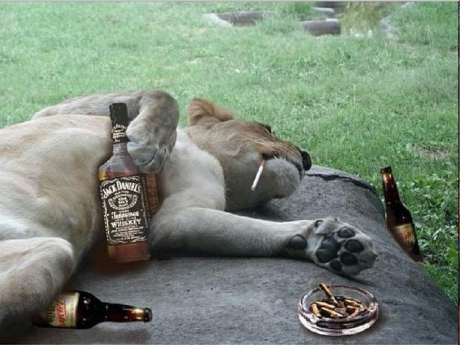
A story of Lions and Excess…
The Cannes International Festival of Advertising is finis. All over Adland people are back at their shops tweaking layouts, creating and debating Power Points and churning out banners. The business of marketing continues. Yet the hangover persists. Not from the overpriced rose’ in Cannes but from its overwrought festival. In the wake of Publicis’ controversial decree to forgo one year of entering work into Cannes or any other awards show, a hazy doubt remains, wafting in it lingering questions about the role of award shows, the cost to participate, and the value they provide.
No doubt award shows had their place, back when work was difficult to share and people harder to connect. But in the age of social media, nothing could be farther from the truth. Everyone sees everything. Shit is condemned. Cream rises to the top. By the time an ad wins an award it has been praised or vilified ad nauseam. Awards have become anti-climactic. Gilding the Lily if you will. Of course recognition is critical for agencies and their people. But claiming prizes well after the fact is antiquated.
But there’s another mitigating fact. Award shows cost a ton of time and money for agencies to participate. I think more than an App named Marcel, this is the real reason Publicis CEO, Arthur Sadoun pulled the plug. In these increasingly difficult times, he saw millions of dollars in savings. The bottom line is the bottom line.
And for this, we cannot blame him. I believe it costs around a thousand dollars to enter a piece of work at Cannes into a sole category. And there are thousands of categories with more every year. Nearly 1,500 Lions were given out this year. Out of God knows how many entries. You do the math. Agencies desperation to win coupled with outright greed by award show executives created a perfect storm. One must pay to play. The gross is gross.
I don’t think award shows should go away –necessarily- but clearly they need to be brought down to earth. There are too many shows with too many categories. Period.
Forget the many losers at Cannes. Let’s look at two of the biggest winners.

“Meet Graham”

“Fearless Girl”
Clemenger BBDO Melbourne was awarded 29 Lions & 2 Grand Prix for their “Meet Graham” campaign. McCaan New York received 18 Lions and 4 Grand Prix for their “Fearless Girl” statue on Wall Street. No question these are wonderful and deserving ideas. But 18 and 29 Lions? That’s icing on the icing on the icing. We may crave the sugar but it’s not good for anyone. Except, of course, the executives at Cannes. They’ll gladly exchange statues for cash.
If only a handful of Lions were given out they would mean so much more. But the current system demand quantity. The solution: Make the show a salon for great work and only give the most brilliant a prize. More like the film festival, which takes place a month before. Hell, if they can do it so can we. I know it’s a tough pill for the many profiteers to swallow. But it’s the right thing to do.
For copy, content and creative direction: https://steffanwork.wordpress.com/

A few 24 hours ago, I had the pleasure of conversing with Alex Bogusky before he became a demi-God of Advertising. We were at a vendor-sponsored pool party in Cannes. However unlikely as it seems, both of us were not really digging the scene. He seemed to prefer a quiet discussion versus living it up in the shallow end. I was perhaps more torn on the issue but also more than happy to oblige him.
For the record, later that week, Alex and his namesake agency would win handfuls of Lions, including the Grand Prix for a charming spot from Ikea called “Lamp.” Crispin Porter & Bogusky were in the middle of an epic run making them perhaps the most famous ad agency on earth.
But Alex wasn’t interested in talking about prizes.

Alex Bogusky, from that period…
Like a lot of executive creative directors (myself included), he’d come to Cannes simply because he could. However, he now admitted to being unsettled by the attention he and his agency were getting. He confessed that this would likely being his last time at Cannes. “Steff,” he said, “we’ve got plenty of swimming pools in Miami.” (This was before CP&B moved its home office to Boulder, CO.) Then he added, “I find that I like doing work more than celebrating it.”
I’m paraphrasing from memory but this was my favorite bit. Ironic commentary coming from the man who would later write “Hoopla” (a book about fame in marketing), not to mention win more Lions than probably any other person or agency in the United States.
Yet, to me, Bogusky’s ambivalence about all of it seemed indicative of a higher power beginning to work in his life: that making work, really good work, was more important than drinking champagne and toasting about it. Bigger picture Alex was also discovering the persistent headache and clash of conscience that hedonism invoked.Lessons I would learn the hard way.
Later that year, Alex resigned from his agency to pursue other interests.
Putting my ego in its place…
In preparation for my family’s move from Chicago to San Francisco, I threw out six boxes of advertising awards I’d amassed during my 20+ years in the business. Among the discards were countless certificates of merit and honorable mentions. Basically booby prizes. I was tempted to keep my first place trophies and Best-in-Shows but for the most part even those I chucked. Made of metal, they lasted ten minutes in the alley before the garbage pickers got them. They took the framed certificates, too, no doubt for the generic black frames. Zero chance some local picker will have use for a 1997 merit award from the Chicago Addy’s. On the other hand those bronze and silver One Show Pencils weigh a ton. Scrap prices are sky high these days. I wonder how many cents each of them netted at the smelter, or wherever it is metal gets bought.
A pair of old-school, badass Lions
I did keep my first two Cannes Lions, a gold and bronze awarded for a TV campaign I wrote on behalf of Heinz Ketchup. The gold was for a spot featuring a teen-aged Matt LeBlanc (Joey from Friends). It’s shown from time to time on nostalgic TV specials. A grainy version can be seen HERE. Back then there were far less categories at Cannes. And broadcast was the king. Ergo, I’m keeping my kitties.
I also kept three Andy Awards and two Clio statues, mostly because they look cool, as well as the Kelly Award given to me by the Magazine Publishers of America for best print campaign in North America: for Altoids. With only one winner, the Kelly was once highly coveted. I should mention it came with a check for $100,000 dollars. Ah, the days when magazine publishers were flush! Win a Kelly now you get a handshake and a photo in Adweek.
Whatever.
Advertising awards seemed so important then. I kept every certificate of merit, every clipping in AdAge. Oh, how I coveted those accolades! I was like a Roman conqueror collecting statues. I was a God of Advertising! Now, as I look upon the heap of paper, plastic and metal in my alley I feel anything but.
Author’s note: I realize this post probably qualifies as a humblebrag, which, according to the Urban Dictionary is where “one, usually consciously, tries to get away with bragging by couching it in a phony show of humility.” I’m pleading ‘No Contest.’
Like a Gold Lion only golder!
My last post on corruption at the International Advertising Festival in Cannes drew quite a few readers, almost breaking the record on my humble little blog. Thank you…I guess. Nothing like timely controversy to goose a blog.
Anyway, I got to thinking about advertising awards shows and what makes them so popular despite the obvious chicanery. Scam ads are as common as pigeons. Most festivals happily accept them. Now we here tell of rigged juries and the calculated “killing” of good work so as to give crappier offerings a better shot. Corruption at all levels from agencies and festivals alike.
So, what is up with the popularity and propensity of advertising awards shows? The big ones continue to thrive despite shenanigans, to say nothing of economic recession and advertising downturns.
There are exactly three reasons why:
- On the receiving end it’s all about the money. Each submission has a startlingly high fee attached. Need I say more?
- Agency creative are egomaniacs with inferiority complexes. We think we are awesome and yet crave validation at every turn. I have this defect as much as you do.
- Awards shows are boondoggles. The judging and/or ceremonies usually take place in exotic locations, like New York or Cannes. We like going to them.
Money. Ego. Hedonism. In other words a petri dish for the awards show virus to flourish. Indeed, more and more strains are added to Cannes bloated category lists every year.
In a classic episode from season three of the Simpsons, “Brother, Can You Spare Two Dimes?” a routine physical exam at the Springfield Nuclear Power Plant reveals that safety inspector Homer Simpson has become sterile after being exposed to radiation. Fearing a lawsuit, plant owner Mr. Burns awards Homer with the “First Annual Montgomery Burns Award for Outstanding Achievement in the Field of Excellence” in exchange for a legal waiver freeing the nuclear plant of all liability.
Hmmmm, Excellence!

“Of course they’re real…Real good!”
The new year is more or less the beginning of awards season in Adland, when all the advertising, digital and design shops gather their best work from 2011 and decide which pieces to enter into what shows. Internal lists are made. Arguments had. Egos tested. Each agency has a different process (and budget) but essentially the routine is similar: someone from the creative administration staff meets with the Chief Creative Officer and goes through the litter. This is not always a pleasant task. The CCO invariably wants to enter more things into more shows than the agency deems possible. In fact, some agencies have massive budgets for these things while many don’t have any money at all. Beseeching the CEO to free up cash is not uncommon.
There is also the matter of fake or “scam ads.” These belong in two camps: 1) Unreal ads for existing clients and 2) Unreal ads for unreal clients. Either way, they are fakes. The pressure to win awards (both imagined and real) is great enough that even creative people with good reputations fall victim to allowing (or downright demanding) that work be created specifically for the purpose of winning prizes. To indemnify themselves, agencies may place scam pieces on late night TV or in obscure publications that charge next to nothing. I have turned this trick myself. Many agencies, especially in emerging markets, do not even bother doing that. In parts of Asia and Latin America, creative directors are considered celebrities of sorts. These rock stars need hits to keep their status and paychecks. Fake ads abound.
I once judged an international awards show where just about every ad on the shortlist was a fake. I was incredulous. Yet, the Chief Juror as well as the show’s promoters muzzled my attempts (and others) from calling out these phonies. Doing so would have wrecked the show, which was a lucrative enterprise. Even fake ads pay admission fees. Besides, the real ads were mostly crap. Choosing from them would have been dismal. In the end, we all became complicit.
Over the last few years, award shows have taken steps (albeit reluctantly) to stymie fake ads. Angry Tweeters and bloggers have made it too risky to give big prizes to big frauds. Still, it is easy to circumvent these systems and fake ads propagate like weeds. Scapegoats are made of one or two and a hundred more slip through the cracks.
One of the greater ironies is that fake ads are easy to spot. Any seasoned creative person knows that a small toy company in Brazil does not do advertising, let alone spreads. And if they did advertise they wouldn’t have approved these ads. Not with that tiny logo at the bottom and no copy or contact information. (Let alone the edgy or poetic concept.)

Edgy concept + Spread + Tiny logo + No copy = Scam
The higher profile scams can be more difficult to spot. In some cases the client has given tacit approval for the piece’s creation but in no way uses it in any of their real marketing plans. In other cases (the most delicate forgeries and the most common), the real ads have been “cleaned up” for awards shows, meaning the logos were shrunk and concessions to retail eliminated. It’s just like touching up a model. I’ve been a party to this. Honestly, I don’t know a creative director who hasn’t. Doctoring the results form is also an issue. Whether facelifts and trumped up credentials constitute scam ads or not (arguments can me made either way) they are like gateway drugs leading the user to trying ever more duplicitous tactics.
I don’t have a solution. At times, I’m not sure one is even needed. Maybe awards shows are just fine being corrupt little fantasies: free booze, networking and a floorshow! Social media pushes good ‘real’ advertising all over the globe anyway. These days publicity for exemplary work happens regardless of awards shows.
Sigh. An App for awards shows.






 The Happy Soul Industry
The Happy Soul Industry The Last Generation
The Last Generation